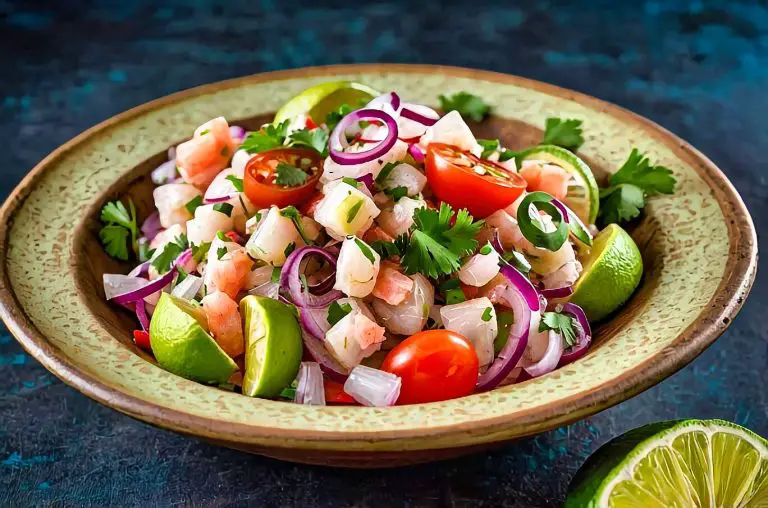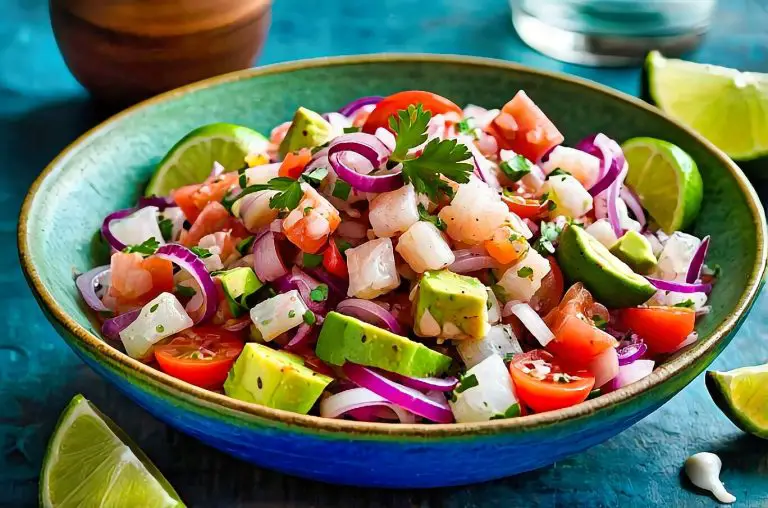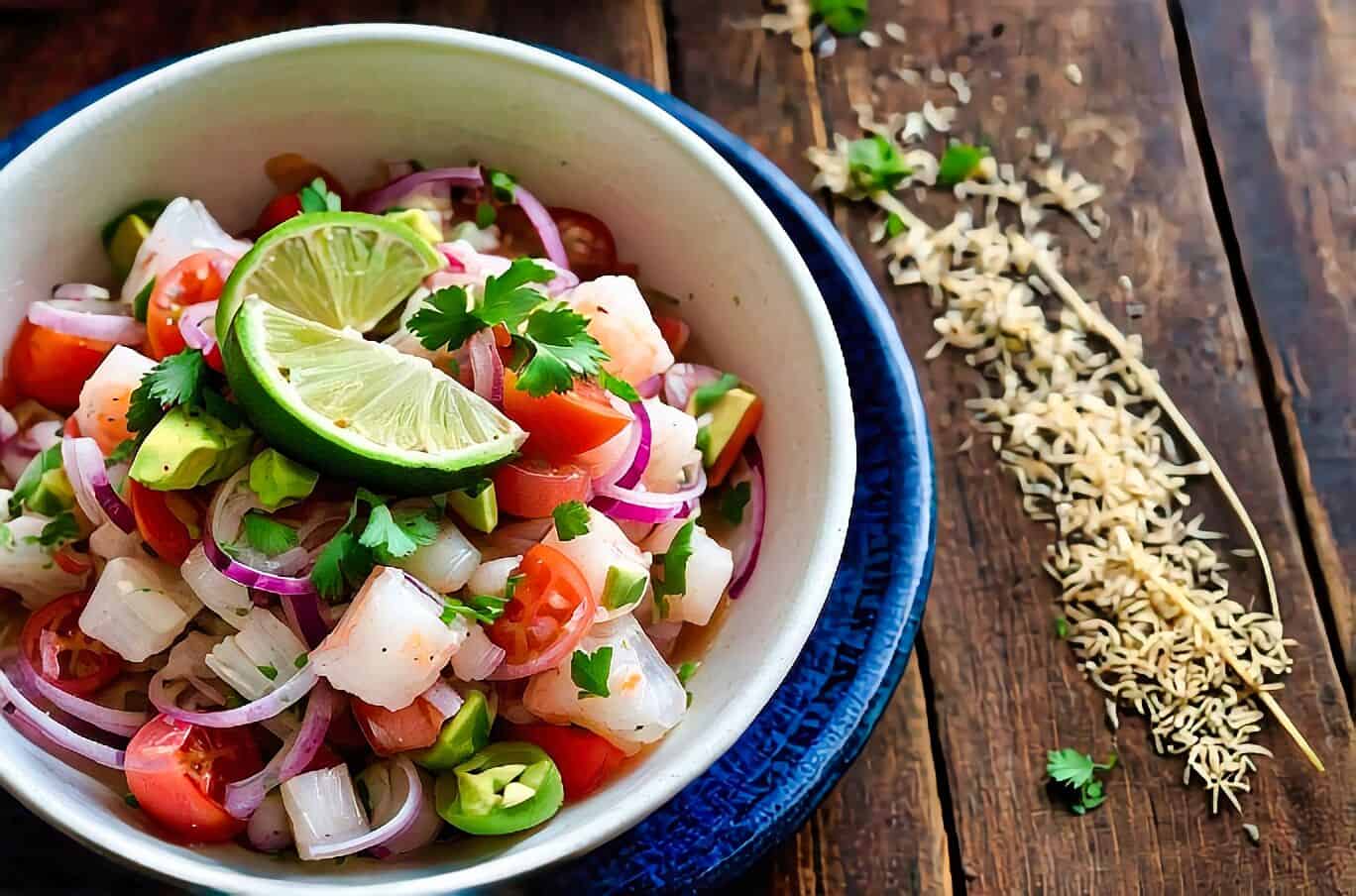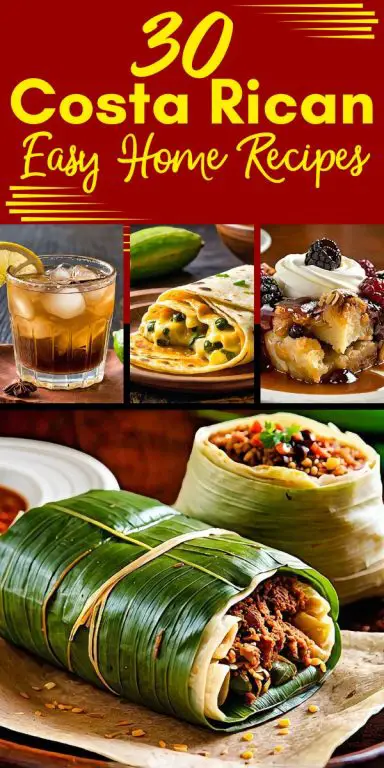The Costa Rican ceviche recipe was just perfect. As a recipe lover, I often look for authentic flavors, and this Costa Rican ceviche recipe is the perfect example of that culinary adventure. I learned how to make it in San Jose, Costa Rica, and truly experienced the local culture. San Jose is a lively city surrounded by mountains, offering both urban charm and natural beauty. The streets are lined with colorful buildings, historical landmarks like the National Theatre and the Pre-Columbian Gold Museum, and markets brimming with fresh produce and local crafts.
My first impression of the ceviche was the fresh ingredients and the vibrant colors on the plate. The traditional Costa Rican ceviche recipe uses fresh fish like tilapia or corvina, served with lime juice. This method preserves the fish while infusing it with flavor. During the cooking class, I saw how the simplicity of the dish allowed the quality of the ingredients to shine. I learned how crucial preparation is for achieving the right balance, as I mixed diced fish with lime juice, cilantro, onions, pepper, and salt.
While there, the instructor explained the big difference between Costa Rican ceviche and versions from other Latin American countries, like Peru. While every region has its own take, the concept remains the same: fresh seafood plus citrus and herbs. I also noticed that Costa Ricans often enjoy ceviche with side dishes like tortilla chips or saltines.
When I tasted the finished ceviche, it was refreshing and revitalizing. The first bite offered tender fish against crisp onions and bright cilantro. Tangy lime juice lifted the dish, balancing the natural flavors of the seafood. This combination made the Costa Rican ceviche recipe a popular choice among locals. It’s the perfect appetizer on hot days or a dish to share with friends at gatherings.
I had the chance to enjoy ceviche at local restaurants in San Jose, where it’s a favorite among locals. I strolled through neighborhoods like Barrio Escalante, a gourmet food scene where many chefs put their own spin on the classic Costa Rican ceviche. I also found that local dining spots often have ceviche on their menus, highlighting its popularity and cultural significance.
I also explored other cooking classes, including tasting trips to small eateries and food stands. Speaking with local chefs or vendors gave me even more insight into the ingredients and methods that weren’t covered in my formal cooking lesson. It became clear to me that the Costa Rican ceviche recipe is more than just a dish – it’s a lifestyle. It reflects Costa Rican culture and hospitality.
Overall, my trip to San Jose was a fantastic opportunity to learn about and experience the Costa Rican ceviche recipe. Whether you’re a seasoned cook or just starting out, this adventure is a great way to enhance your skills and dive deeper into Costa Rican cuisine.
Over your trip to San Jose, Costa Rica, you should definitely take the opportunity to learn the Costa Rican Ceviche recipe. This iconic dish reflects the vibrant culture and culinary traditions of the country, and participating in a cooking class hands-on really enhances your understanding of it. San Jose, the capital, serves as a great base for exploring Costa Rica’s attractions. The cosmopolitan city features a variety of museums, parks, and a bustling market scene. The Central Market, Mercado Central, is one of the best places to explore, making it a perfect stop before or after your class. Here, you can observe local ingredients that contribute to the flavors of the Costa Rican Ceviche recipe.
Your first impressions of the dish will set the tone for your experience. Ceviche in Costa Rica primarily involves fresh fish, lime juice, and fresh vegetables. As you learn to prepare the dish, you will notice how simple ingredients come together to create something remarkable. The preparation is straightforward—by marinating the fish in lime juice, the acid naturally “cooks” the seafood, giving it a unique texture and flavor. Throughout the class, the instructor will guide you step by step, explaining the purpose of each ingredient and how they enhance the final product.
The taste of the Costa Rican Ceviche recipe is fresh and tangy, with a hint of heat from local peppers. You will likely find that the texture is firm yet tender, allowing the fish to hold its form while being infused with flavors. Accompanied by diced onions, cilantro, and tomatoes, there is an excellent balance of textures that provide a refreshing sensation, especially when served chilled. After preparing your ceviche, you may have the option to sample your creation alongside traditional accompaniments such as tortilla chips or plantain.
Ceviche is incredibly popular with locals in the area. You will notice that it is often featured at parties, family gatherings, and restaurants. The dish symbolizes the local love for fresh seafood and highlights Costa Rica’s bountiful Pacific coastline. By learning the Costa Rican Ceviche recipe, you are incorporating a piece of the culture into your cooking repertoire. You will likely find that this dish is not just a meal but also a way to connect with the community and heritage of Costa Rica.
Exploring San Jose and participating in a cooking class will provide you with deeper insights into the local cuisine. The Costa Rican Ceviche recipe will become one of your go-to dishes to replicate, allowing you to share a taste of Costa Rica with friends and family back home. Whether it is enjoyed as a main course or appetizer, the fresh flavors of this ceviche will surely leave a lasting impression.
So, when planning your next trip, consider making San Jose a destination. Engaging in local cooking classes where you can master the Costa Rican Ceviche recipe will surely enhance your travel experience while offering a delicious aspect of Costa Rican culture.

Ingredients For the Costa Rican Ceviche Recipe
Fresh fish fillet, (such as snapper or tilapia), cut into small cubes
Lime juice, freshly squeezed
Red onion, thinly sliced
Red bell pepper, seeded and finely chopped
Jalapeño pepper, seeded and finely chopped
Cilantro, fresh, chopped
Salt
Black pepper
Olive oil
Cooking Instructions For the Costa Rican Ceviche Recipe
Place the fish cubes in a large glass or ceramic bowl and pour the lime juice over them. Stir to combine and make sure all the fish is covered by the juice. Cover the bowl and refrigerate for 2-3 hours, stirring occasionally.
After 2-3 hours, the fish should be opaque and “cooked” by the acid in the lime juice. Drain the excess liquid from the fish. Add the sliced red onion, chopped red bell pepper, jalapeño pepper, cilantro, salt, black pepper, and olive oil to the bowl with the fish. Stir well to combine all ingredients.
Cover the bowl and refrigerate for at least 30 minutes before serving to allow the flavors to meld together.
Serve cold with tortilla chips, avocado slices, and lime wedges.
Healthy Eating Options in Costa Rica
This is a country where fresh, local produce and a diet of plant-based foods are essentials making Costa Rica a particularly healthy and balanced food destination. The Costa Rican way of consuming food is delicious and beneficial to the health; it’s an example of a diet for a long healthy life. The country’s cuisine reflects a culture that emphasizes natural, nutrient rich foods, featuring plenty of fruits and vegetables, whole cereals in addition to lean proteins.
Fresh, seasonal produce is part of why Costa Rican food is so healthy. The country’s tropical climate means that many fruits and vegetables can be grown year round to provide nutrient rich options. Costa Ricans consume a lot of fresh fruits – bananas, pineapples, mangos and papayas – rich in vitamins, antioxidants and minerals. Vegetables like carrots, zucchini and bell peppers are also used in meals every day. They contain fiber, vitamins and minerals which aid an immune system, digestive health and energy production.
Besides fresh vegetables and fruits, staples in Costa Rican food are whole grains like beans and rice. The rice and beans are a tasty dish and complete with protein. This meal is usually served with vegetables. The high fiber content of beans moderates blood sugar and promotes heart health. Rice is high in energy and provides the carbohydrate fuel for daily life when eaten in moderation.
Another reason Costa Rican food is healthy is because it contains lean proteins. Fish like fresh tuna, snapper and tilapia is eaten extensively along the Pacific and Caribbean coasts. Fish consists of omega 3 essential fatty acids which are great for the heart and decreasing inflammation. Chicken also is a protein source in Costa Rican meals that are often prepared in simple, healthy ways such as by grilling or boiling and without added fats or oils. These lean proteins help repair muscle and provide nutrients for the body.
Good fats are also utilized in Costa Rican cuisine, which includes olive oil and coconut oil. Olive oil is used to saute vegetables and in salad dressings, a healthy extra fat that supports cardiovascular health. Coconut oil is utilized in cooking and baking and also contains medium chain essential fatty acids which could boost metabolism and support health. They’re healthier alternatives to the processed vegetable oils found in many Western diets.
The culture of “pura vida,” or the pure life, is at the core of Costa Rican values – and that includes their food. Sometimes meals are simple and carefully prepared using whole, minimally processed ingredients. Costa Ricans also tend to eat moderately and share meals with family and friends – a lifestyle that promotes mindful eating. This cultural approach to food encourages a relationship with food and helps with digestion and health.
Lastly, Costa Rican food doesn’t have added sugars and processed foods, which are common reasons for disease in a great deal of the world. The natural sweetness of fruits often suffices for a sweet tooth and processed snacks or sugary treats are not a regular part of the Costa Rican diet. This aids in weight maintenance and lowering the risk of chronic diseases like heart problems.
Finally, healthful eating options in Costa Rica stem from fresh, local ingredients, lean proteins, whole grains and healthy fats. The natural, nutrient dense foods in Costa Rican food are delicious and beneficial to health and wellness. No matter whether it is beans and rice with veggies, a fresh fish dish or tropical fruit, Costa Rican food provides a wholesome and balanced way to consume which may assist anybody desiring to live a healthier lifestyle.
How to Find Local Restaurants and Diner Favorites in Costa Rica
Costa Rica has a variety of local foods reflecting its culture and natural landscapes. Finding the best local restaurants and diner favorites is a must when visiting the capital of San Jose or the more laid-back coastal towns. Finding these hidden gems and popular spots can be a rewarding experience for anyone looking for authentic flavors and local life.
Regional restaurants in Costa Rica can often be found through word of mouth. Costa Ricans are proud of their food and often have opinions on where to get the best meal. Asking locals for recommendations will lead you to a few of the most widely used places which aren’t in guidebooks and on popular travel sites. These little, family owned eateries are usually where you’ll find the most authentic Costa Rican dishes prepared with care and utilizing local produce. Ask hotel staff, tour guides or even shopkeepers for suggestions – Costa Ricans usually are more than happy to recommend restaurants to visitors.
Another great way to find local restaurants is at the markets. Farmers’ markets (ferias) are found in most cities and towns throughout Costa Rica and offer a wide variety of fresh produce, meats and prepared meals. These markets may include small food stalls where you can grab quick, cheap meals that showcase the country’s culinary traditions. Try a casado, a typical Costa Rican dish that includes rice, beans, plantains, salad and a protein (chicken or fish). Some vendors also sell fresh fruit juices, tropical fruits and snacks such as empanadas or tamales. At a market you can sample local food and enjoy the atmosphere while meeting locals.
For those seeking more well established restaurants, there are numerous food guides and online resources to assist you. Sites such as TripAdvisor, Yelp along with Google Maps allow reviews by other travelers who’ve eaten at restaurants in Costa Rica. Even though these platforms will help you locate hot spots, you should look at the reviews which mention local dishes first, because they are going to give you a much better idea of the authenticity and quality of the meals. Look for restaurants focusing on traditional Costa Rican cuisine; these are likely to showcase the country’s flavors.
The soda is one of the most popular types of local dining spots in Costa Rica. A soda is a small, casual diner that specializes in traditional Costa Rican food at a reasonable price. These family-run places tend to have simple menus that change daily and include things like gallo pinto, arroz con pollo, and sopa negra, but are also where you can taste the heart of Costa Rican home cooking. These local diners can be found in most cities and rural areas so you’re bound to find a soda near you.
Many seafood-focused restaurants serve fresh fish and other ocean fare in Costa Rica’s coastal areas, like Guanacaste or the Nicoya Peninsula. Visiting these coastal towns will give you ceviche (fresh marinated seafood), grilled fish, and cevichada (a seafood stew), all made from scratch. A lot of these eateries have a laid back beachside feel with ocean views and an area to unwind and enjoy your food.
For all those who wish to go off of the beaten track, go on a culinary tour. Many local tour operators offer food-focused excursions to hidden gems, food stalls and markets throughout Costa Rica. These tours might consist of visits to local farms, in which you are able to find out about ingredients used in Costa Rican cooking and prepare a meal prepared with farm produce. These tours are an excellent way to get to know the regional culinary tradition, with skilled chefs introducing dishes and tales behind them.
And lastly, social networks like Instagram are an excellent way to discover local food in Costa Rica. Many restaurants and food bloggers in the country post photos and videos of dishes and their locations. Searching for relevant hashtags like # costaricanfood or # costaricanrestaurants yields recommendations and a visual preview of what to expect before you go to a restaurant.
Finding local restaurants and diner favorites in Costa Rica means just wandering around the country with an open mind and curiosity. Whether you ask local recommendations, visit farmers’ markets or book food-focused tours, Costa Rica has plenty of opportunities to sample authentic, tasty meals reflecting the country’s food culture. From small sodas to seafood restaurants along the coast, dining in Costa Rica will provide you with fresh flavors and memorable experiences.

FAQ For the Costa Rican Ceviche Recipe
Question: What is the Costa Rican Ceviche recipe?
A: The Costa Rican Ceviche recipe is a refreshing dish made with fresh fish or seafood marinated in lime juice and mixed with ingredients like onions, cilantro, and peppers. It’s a popular appetiser in Costa Rican cuisine.
Question: What ingredients are needed for a Costa Rican Ceviche recipe?
A: A Costa Rican Ceviche recipe typically includes fresh fish or shrimp, lime juice, finely chopped onions, cilantro, bell peppers, and optional ingredients like garlic or hot peppers for added flavor.
Question: How is the Costa Rican Ceviche recipe prepared?
A: To prepare a Costa Rican Ceviche recipe, fresh fish or shrimp is diced and marinated in lime juice until it’s “cooked” by the acidity. Chopped onions, cilantro, and peppers are then mixed in to enhance the flavors.
Question: Can the Costa Rican Ceviche recipe be made with different types of seafood?
A: Yes, the Costa Rican Ceviche recipe can be made with various types of seafood, such as shrimp, octopus, or even a combination of seafood, depending on your preference. Freshness is key for the best results.
Question: Is the Costa Rican Ceviche recipe suitable for special occasions?
A: Absolutely, the Costa Rican Ceviche recipe is perfect for special occasions. It’s a light and flavorful dish that works well as an appetizer or a snack during gatherings and celebrations.

Costa Rican Ceviche Recipe
Ingredients
- 2 pounds snapper fillets or tilapia cut into small cubes
- 1 cup lime juice freshly squeezed
- 1 red onion thinly sliced
- 1 red bell pepper seeded and finely chopped
- 1 jalapeño seeded and finely chopped
- 1/4 cup cilantro fresh, chopped
- 1 teaspoon salt
- 1/4 teaspoon black pepper
- 2 tablespoons olive oil
Instructions
- Place the fish cubes in a large glass or ceramic bowl and pour the lime juice over them. Stir to combine and make sure all the fish is covered by the juice. Cover the bowl and refrigerate for 2-3 hours, stirring occasionally.
- After 2-3 hours, the fish should be opaque and "cooked" by the acid in the lime juice. Drain the excess liquid from the fish. Add the sliced red onion, chopped red bell pepper, jalapeño pepper, cilantro, salt, black pepper, and olive oil to the bowl with the fish. Stir well to combine all ingredients.
- Cover the bowl and refrigerate for at least 30 minutes before serving to allow the flavors to meld together.
- Serve cold with tortilla chips, avocado slices, and lime wedges.



2 comments
I cant believe they didnt mention the importance of using fresh lime juice in the ceviche recipe! Its a game-changer for the flavor. Definitely worth adding to the cooking instructions.
I cant believe they didnt mention the importance of using fresh seafood in the Costa Rican Ceviche recipe! Its a game-changer for the flavor. Anyone else agree?